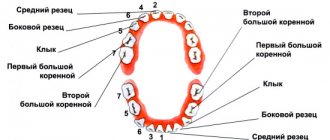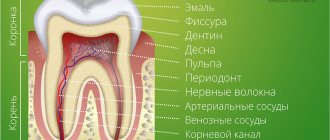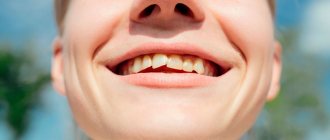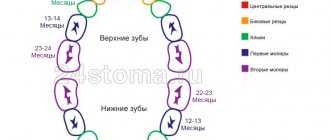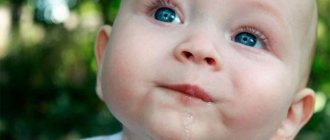How does teeth change?
The rudiments of future permanent units are located under the root of the baby tooth and are separated from it by a thin bone septum. At 6–7 years of age, osteoclasts of the connective tissue surrounding the baby tooth dissolve the mineral component of the septum and destroy it. At the same time, the pulp of the temporary unit is gradually transformed into granulation connective tissue rich in osteoclasts, which gradually destroy the dentin of the primary tooth. At the same time, the roots of the temporary units dissolve and, in fact, only the crown of the baby tooth remains. It can be easily removed on its own, with the help of the dentist’s manipulations, or it can be pushed out by an actively growing molar (permanent) tooth.
Anatomy of permanent teeth The permanent units of a child (and an adult) have a complex anatomy.
Visually, the tooth consists of three parts - crown, neck, roots.
- The crown is the visible part of the tooth that rises above the gum.
- The neck is the part of the tooth at the gum level, in the place where the crown meets the root, and the enamel of the unit turns into cement.
- The root is the part of the unit invisible to the eye, located in the alveolar socket. The base of each unit is made of dentin, a hard tissue. In the coronal part, dentin is covered with enamel, and in the root part there is cement. Inside the dentin is the dental pulp - loose fibrous soft connective tissue, penetrated by a large number of blood and lymphatic vessels and nerve endings. Passing along the root canal, through the apical foramen located on the upper part of the root, they communicate with the main neurovascular bundle, providing nutrition to the tooth, drainage of excess fluid and its innervation.
Normally, by the age of 13, when a permanent bite is formed, a child has 28 permanent teeth. At the age of 17 - 25 years, third molars (wisdom teeth) erupt and the number of units may increase - 32 teeth.
Teeth in children 5-6 years old
Parents often ask: how many teeth does a child have at 5 years old? Normally there are 20 baby teeth, which should all be replaced by permanent teeth, normally up to 12 years of age. Here is the answer to another frequently asked question: what kind of teeth do children change? Please note once again - all baby teeth fall out and are replaced with permanent ones!
And those 6th molars that erupt after 5 years of age, and which most parents consider to be milk teeth, are the FIRST PERMANENT TEETH ! We deliberately highlighted this information in large font, because many parents think that these are delayed baby teeth and simply miss their list of what requires close attention. And when, at the age of 8-9, it turns out that these PERMANENT TEETH have already been eaten away by caries, it will be too late to regret. Here, without the desire to once again advertise ourselves, we once again invite the obligation of constant dental monitoring of the child, preferably with one doctor (this is generally ideal), from a very early age. Let it be at least a pediatrician (but qualified and regularly!), let it be a district dentist, or specialists from the Utkinzub dental clinic.
We offer you constant and qualified supervision of your child almost from the moment of birth until adulthood. In this case, our clinic guarantees a timely, highly effective modern response to all kinds of problems that arise during the growth of your child, treatment at the very initial stages of diseases or various pathological conditions, including injuries to which adolescents are often susceptible, as well as emergency dental medical assistance. Or qualified consultations on all issues that concern you.
Teeth in children 5-6 years old
The teeth of 6-year-old children require no less close attention than those of a year or 14 years old. 5-6 years of age, when a child can already be explained at a fairly high level the importance of the health of the dental system and the need for quality care. Modern dentistry offers a universal procedure - sealing fissures (fissures are natural grooves in the molars, i.e., molar teeth), which are primarily susceptible to caries, since they bear the greatest load. Article “What is fissure sealing. Everything about the procedure itself and the expected results.”
Almost half of children aged 7-8 years complain of pain in the teeth (or rather, pain in the jaws) for no apparent reason. That is, all existing teeth are safe and sound. There is a completely natural explanation for this: the rudiments of permanent teeth, which are almost twice as large as milk teeth, are actively growing - they need a place that often does not yet exist for various reasons. This condition is normal and does not require treatment. If the pain is very severe, contact the Utkinzub dentist, or give your baby painkillers at the same time - and be sure to consult a doctor the next day.
For this reason, uneven growth of permanent teeth and their incorrect location are often observed: overlapping each other, bulging forward or sinking into the oral cavity. The growth of the second row of teeth is a separate matter. (“Absence of milk teeth – adentia. Second row of teeth”).
Timing and order of eruption of permanent teeth
Normally, the eruption of permanent units occurs 3 to 4 months after the loss of baby teeth. In girls, this process occurs a little earlier and faster than in boys. In both sexes, the first lower molars appear first. Then the sequence of eruption of permanent teeth is approximately the same as for milk teeth and looks as follows.
- 6 - 7 years - central incisors.
- 7 - 8 years - lateral incisors.
- 9 - 12 years - fangs.
- 10 - 12 years - premolars.
- 10 - 12 years - molars.
The eruption of the second molars completes the formation of the permanent dentition.
Problems that arise during teething in children
During the teething process you may encounter the following problems:
- Late or early appearance.
Most often, early teething can occur with the lower central incisors. Sometimes a child may already be born with them.
Late teething is possible due to poor nutrition of the child, as well as past illnesses and concomitant chronic pathologies.
- Violation of the order and pairing of teeth eruption.
It is also possible that one or more teeth are missing from the dentition. This situation is possible due to the death of the embryos during the prenatal period of the baby’s development.
- Increase in temperature during teething.
The main differences between baby teeth and permanent teeth
Unlike 28 permanent teeth, the primary dentition requires the presence of 20 units. At the same time, they have a number of characteristic features.
- Smaller in size compared to permanent teeth.
- White with a slightly blue tint (permanent units have a slightly yellowish tint).
- Less developed and slightly short roots compared to permanent teeth.
- The enamel of primary teeth is poorly formed - thinner.
- Milk units can be erased (permanent ones can too, but this is considered a pathology).
As the child grows, baby teeth fall out on their own - this is the norm. The permanent dentition units should not fall out on their own.
Baby teeth teething calendar
Most children's primary teeth appear in a specific order.
Here's how it will likely happen 5-8 months 8-10 months 10-12 months 12-14 months 14-18 months 18-22 months
5-8 months
The lower middle teeth, the incisors, usually appear first, between 5 and 8 months. These little pioneers usually show up almost simultaneously.
8-10 months
The upper middle teeth will erupt next, usually between 8 and 10 months. Now the baby looks like a cute bunny!
10-12 months
From about 10 to 12 months, you will see your upper teeth to the right and left of center.
12-14 months
The lower teeth to the right and left of center appear at approximately 14-16 months. Now your little one can flash a pretty toothy smile.
14-18 months
first molars —the wider teeth at the back of the mouth—will emerge on the upper jaw between about 14 and 18 months. But they won't be loaded until their buddies below show up.
Antagonists on the lower jaw appear at approximately the same period of time, but a little later. Now your little one can really show the crackers who's boss.
18-22 months
The upper canines fill the void between the incisors and first molars between 18 and 22 months of age, maybe a little earlier.
The lower canines appear around 17-23 months.
By about the age of three, a child has a full set of 20 baby teeth.
Now your little one can flash a pretty toothy, snow-white smile. Baby's teeth are now brighter than ever! After all, baby teeth are whiter than permanent teeth.
How to determine that a child will soon have molars?
An increase in jaw size is the main sign of a future change of teeth. Visually this may not be noticeable. But the appearance of three and diastema (gaps) between the baby teeth indicates that the child’s jaw is growing and preparing for the formation of a permanent bite.
The following signs are purely individual - they may or may not be present in the child.
- Increased salivation.
- Redness, swelling of the gums and oral mucosa.
- Sore gums.
- Unpleasant itching of the gums.
- Increased body temperature.
- Unreasonable cough, runny nose.
- Stool disorder.
- General malaise, lethargy.
- Loss of appetite.
- Sleep disturbance or, on the contrary, drowsiness.
- Anxiety, irritation, whims.
Important! During the period of permanent teeth erupting, parents should monitor the condition of the child, the oral cavity and gums. If symptoms that cause concern appear, you should immediately consult a doctor - a pediatrician or pediatric dentist.
Possible problems
Despite the fact that changing teeth is a natural physiological process, some children and their parents may encounter a number of problems that require contacting a pediatric dentist.
No molars
The absence of permanent units can be caused by congenital edentia - the complete or partial absence of tooth buds.
Another reason for the absence of molars is previous inflammatory diseases - periostitis or periodontitis, resulting from progressive caries. Inflammatory diseases of the periosteum and periodontal tissues have an extremely negative effect on the condition of the tooth buds and can lead to their death.
Important! It is absolutely necessary to treat baby teeth for caries. You should not assume that the problem will go away on its own with the change of teeth. The progression of the disease can negatively affect the health of the tooth buds.
Molar tooth hurts
The enamel of newly emerging permanent teeth is still poorly formed. The low level of its mineralization makes teeth vulnerable to cariogenic microflora. This can lead to the development of caries and cause pain.
Due to poorly formed enamel, tooth sensitivity to external irritants (cold, hot, sour, sweet) may increase, which is also accompanied by painful sensations.
Important! Normally, permanent teeth do not hurt. If pain occurs, you should contact your pediatric dentist. The specialist will determine the cause of the pain, carry out the necessary treatment, fluoridation or remineralization of tooth enamel.
Molars grow crooked
The incorrect position of permanent teeth can be caused by two reasons - the growth of the permanent unit outpaces the process of loss of baby teeth or they were removed ahead of schedule, which led to incorrect formation of the rudiments of permanent teeth.
In this case, there is only one way out - orthodontic treatment of malocclusion.
Important! A malocclusion must be corrected. The sooner you contact a dentist, the more successful the treatment will be. The child will be prescribed to wear removable or fixed orthodontic appliances that will help straighten the permanent teeth and bite.
Injuries
Due to their activity and lack of experience, children can accidentally injure a newly emerging permanent tooth. Due to mechanical damage, cracks and chips may appear on it. The damage looks unattractive. Caring for such teeth is complicated, since food debris can get stuck in the cracks, which will certainly lead to the development of caries.
Important! If a child accidentally injures a permanent tooth, it is necessary to seek help from a dentist. The specialist will assess the complexity and depth of the damage and will build up the missing volume of tooth tissue with composite materials.
Tooth loss
Loss of healthy permanent teeth can only occur as a result of severe trauma to the jaw, for example, during a child’s fall or fight. A diseased molar may fall out on its own. In this case, you will also need to consult a specialist. Most likely, the child will undergo temporary prosthetics for the lost unit, which will not disrupt the formation of a correct permanent bite.
The tooth is loose
Looseness of a permanent tooth is an alarming symptom indicating a pathology of the dentofacial apparatus or the presence of inflammation. Consultation with a specialist is required!
Treatment of permanent teeth
Treatment of caries of permanent teeth in children is carried out according to the same principle as in adults, only with the use of special photocomposites.
Stages of treatment:
- Introduction of anesthesia.
- Removal of affected tissue. Typically, pathogenic foci are eliminated using a drill, after which the cavity is thoroughly cleaned.
- Treatment of teeth with antiseptic preparations.
- Drying with air jet.
- Application of phosphate cement insulating material.
- Filling.
The initial stage of caries is treated with remineralization or, for example, ozone therapy. The silvering method is not used for permanent teeth.
Do baby teeth need to be treated?
Many people believe that if a tooth falls out anyway, then it does not need treatment. In fact, this is far from the case. Baby teeth perform very important functions. They ensure proper growth of the jaw, protect the rudiment of the permanent unit from infection by pathogenic microbes and prevent the development of malocclusion. If a baby tooth is not treated, caries penetrates deep into the tissue, which inevitably causes damage to the rudiment. In the future, this leads to various pathologies, including dental anomalies, speech disorders and much more. To avoid this, it is very important to carry out timely treatment of baby teeth at the first stage of disease development, and not to remove them.


